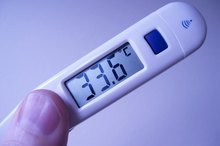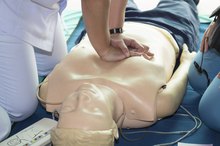What does fact checked mean?
At Healthfully, we strive to deliver objective content that is accurate and up-to-date. Our team periodically reviews articles in order to ensure content quality. The sources cited below consist of evidence from peer-reviewed journals, prominent medical organizations, academic associations, and government data.
The information contained on this site is for informational purposes only, and should not be used as a substitute for the advice of a professional health care provider. Please check with the appropriate physician regarding health questions and concerns. Although we strive to deliver accurate and up-to-date information, no guarantee to that effect is made.
How to Measure Someone's Pulse & Respiration
Pulse and respiration are two of the body's four vital signs 1. The other vital signs are body temperature and blood pressure 1. Vital signs measure the body's functions and doctors and nurses take these measurements to help assess your physical health 1. Abnormalities in the vital signs can indicate disease or illness or measure steps toward recovery following surgery, illness or infection 1.
Sit the patient on an exam table or in a chair. Make sure the patient is relaxed and comfortable before you start the examination. Her back should be supported and she should have her feet flat on the foot rest of the exam table or on the floor for best results. Ask the patient about her medical history. It is important to document current medications, a history of hypertension or a history of slow or rapid pulse as all these considerations could affect the patient's pulse rate and respiratory rate.
Instructions for a BD Digital Thermometer
Learn More
Stand facing your patient. Turn her hand over so her palm is facing upward on the side on which you want to take the pulse. Place your first and second fingers on the outside of the patient's wrist, just below the point where the hand meets the wrist on the same side as the thumb. You should feel a slight indent on the wrist where the artery lies and by gently pressing, you should feel the patient's pulse.
Note whether the pulse is normal, regularly irregular or irregularly irregular. A regular pulse has evenly spaced beats, a regularly irregular pulse has an irregular pattern throughout -- usually indicating skipped beats -- and the irregularly irregular pulse does not have a real pattern and is very difficult to measure. If the patient has a regular pulse, count the number of beats in 15 seconds and multiply that number by four to get the number of beats per minute. If the patient has an irregular pulse, take the pulse for a full minute and record the number of beats per minute.
How to Use a Portable Suction Machine
Learn More
Continue holding the patient's wrist while you measure her respiration. Don't tell the patient you are going to measure her respiration because some people will change their respiration rate if they know it is being measured. Watch the patient's shoulders and chest and count each inhalation as one breath. Count the number of breaths in 15 seconds and multiply the number by four to get the number of respirations per minute. Note whether the breathing is labored or normal and record the number and observation of the respirations.
Tips
A normal adult resting heart rate is between 60 and 80 beats per minute. A pulse greater than 80 beats per minute is called tachycardia and a pulse rate less than 60 beats per minute is called bradycardia.
The normal adult rate of respiration is 12 to 20 breaths per minute. Respiration rate over 20 per minute is called tachypnea.
Warnings
Do not perform these measurements on someone who has consumed alcohol or tobacco or worked out vigorously in the 30 minutes prior to the exam.
Don't use your thumb to take the patient's pulse. Your own pulse is stronger in your thumb than any of your other fingers, so you may mistake your own pulse for theirs when performing the examination.
Related Articles
References
Warnings
- Do not perform these measurements on someone who has consumed alcohol or tobacco or worked out vigorously in the 30 minutes prior to the exam.
- Don't use your thumb to take the patient's pulse. Your own pulse is stronger in your thumb than any of your other fingers, so you may mistake your own pulse for theirs when performing the examination.
Writer Bio
Based in Dayton, Ohio, Sari Hardyal has been writing fitness, sports, entertainment and health-related articles for more than five years. Hardyal holds a Bachelor of Science in mass communication from Miami University and is pursuing her master's degree in occupational therapy and her doctorate in physical therapy. She is a certified personal trainer with the National Federation of Professional Trainers.





